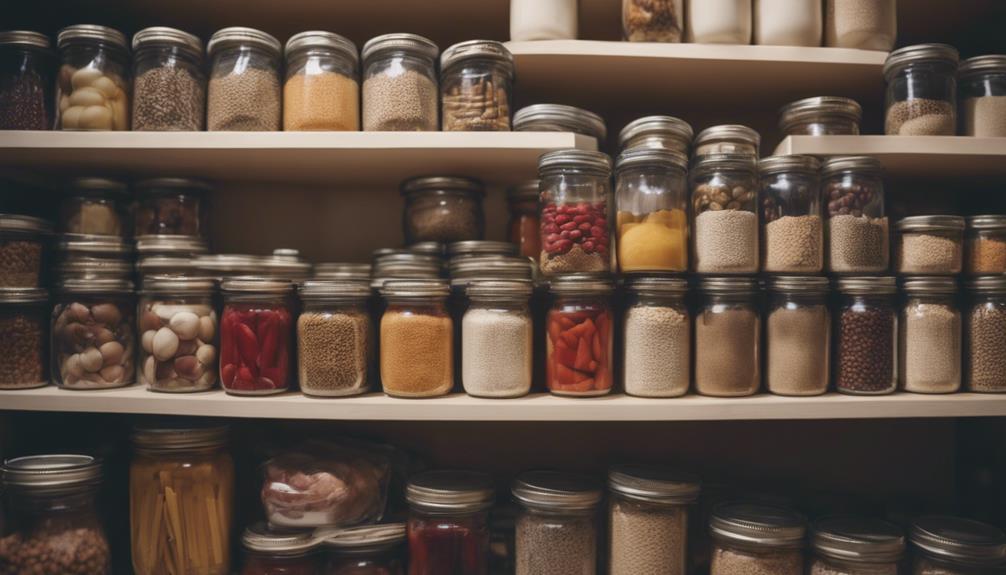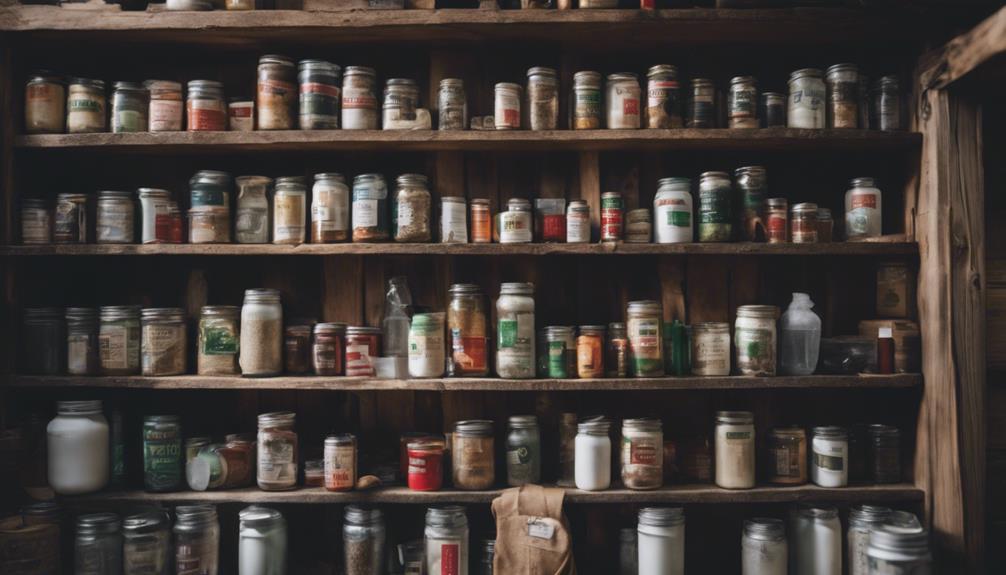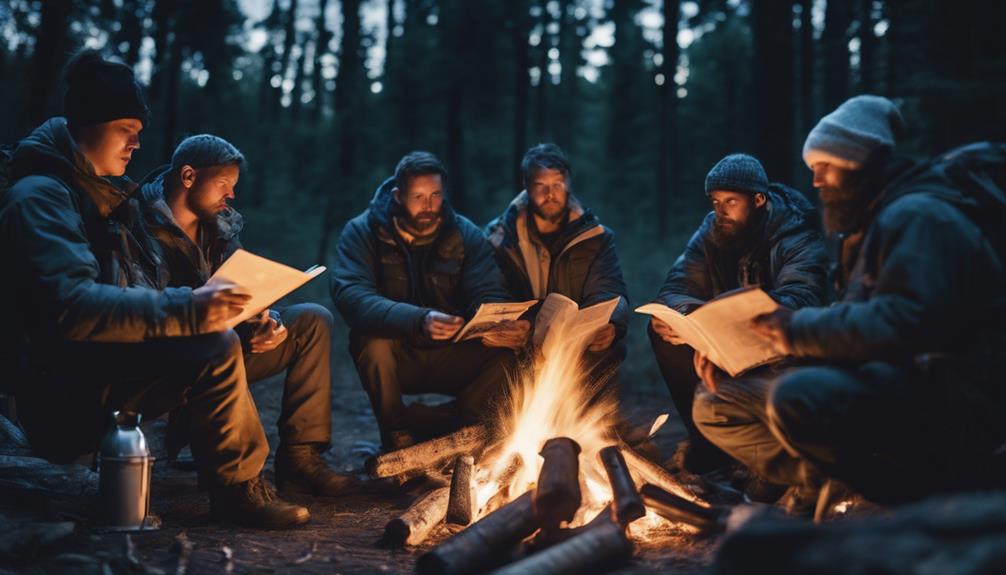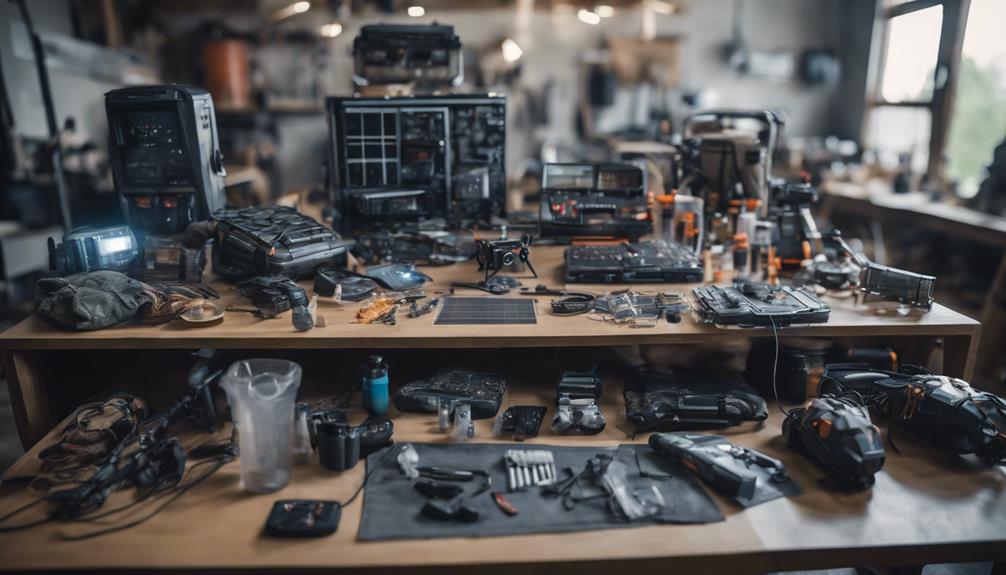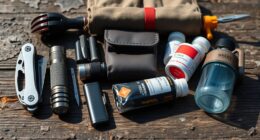To build a long-lasting pantry as a food prepper, stock up on staples like rice, pasta, and canned proteins such as tuna. Include essential seasonings and store items in a cool, dark, and dry place. Use canning, freezing, and dehydrating to extend food shelf life. Rotate items, label with expiration dates, and follow a FIFO system. Guarantee a variety of food groups like grains, proteins, fruits, and vegetables for balanced nutrition. Embrace sustainable practices with eco-friendly storage and sourcing. Start with these tips to fortify your pantry for emergencies and beyond.
Key Takeaways
- Stock up on long-lasting staples like rice, pasta, canned proteins, and important seasonings.
- Utilize canning, freezing, and dehydrating methods for extended food storage.
- Rotate pantry items with FIFO system and label with expiration dates for replenishment.
- Include diverse food groups for balanced nutrition during emergencies.
- Practice sustainability with eco-friendly storage methods and locally sourced, organic items.
Pantry Essentials for Food Preppers
Building a well-rounded pantry for food preppers involves stocking up on essential items to guarantee preparedness and sustainability. Pantry essentials for food preppers include a variety of long-lasting staples such as grains like rice and pasta, canned proteins like tuna, and important seasonings like salt and spices.
These shelf-stable and non-perishable items are vital for ensuring food security during emergencies. Proper storage in a cool, dark, and dry place is key to maintaining the quality and longevity of these pantry essentials.
Strategies for Long-Term Food Storage

When preparing for long-term food storage as a food prepper, it's important to implement efficient strategies such as utilizing canning, freezing, and dehydrating methods. These methods help preserve food for extended periods, ensuring you have a stockpile of shelf-stable items for emergencies.
Canned goods, dry beans, and other non-perishable items are excellent choices for long-term storage due to their extended expiration dates. Buying in bulk can also be cost-effective for stocking up your pantry with essentials.
To maintain the quality of your stored food, rotate items regularly by using older items first and replacing them with fresh supplies. Labeling items with expiration dates is essential for proper rotation and to prevent food waste.
Store your long-term food supply in a cool, dark, and dry place to maximize shelf life. Remember to include a variety of food groups in your pantry to ensure balanced nutrition during emergencies.
Rotation and Replenishment Tips

To maintain a well-organized and efficient pantry, it's essential to implement proper rotation and replenishment strategies for your food prepping needs. Start by regularly rotating pantry items to ensure that older products are used first.
Label items with expiration dates so you can track when they need replenishment. As you use items, make sure to replenish them promptly to keep your pantry well-stocked.
Implementing a 'first in, first out' (FIFO) system is vital to prevent items from expiring before use. Keep an eye on your pantry inventory to avoid running out of essential items unexpectedly.
Diverse Food Group Inclusion

Including a diverse range of food groups in your prepper pantry is essential for balanced nutrition during emergencies. To build a long-lasting and well-rounded stockpile, aim to incorporate grains, proteins, fruits, vegetables, fats, and dairy alternatives. Don’t forget to include items that are nutrient-dense and have a long shelf life, such as beans, rice, canned fish, and peanut butter. These prepping essentials for food supply will ensure that you have access to both calories and essential nutrients when fresh options may not be available. Additionally, consider stocking spices and condiments to enhance flavor, which can boost morale during stressful times.
Diversifying food groups not only helps meet the dietary needs of different family members but also guarantees you have options for creating balanced meals without access to fresh ingredients. By balancing the food groups in your pantry, you enhance the overall nutritional value of your emergency food supply.
This diversity is vital for food preppers as it caters to various nutritional requirements and preferences. During times of crisis, having a pantry stocked with a variety of food groups will provide you with the necessary nutrients to maintain your health and energy levels.
Sustainability Practices for Prepper Pantries

To enhance the sustainability of your prepper pantry, focus on implementing eco-friendly practices and sourcing methods. Utilize sustainable storage methods such as glass jars, reusable containers, and eco-friendly packaging to reduce waste and promote long-term storage.
Opt for locally sourced and organic food items to support sustainable farming practices while ensuring the quality of your pantry supplies. Implementing a composting system for food scraps and expired items helps minimize landfill waste and contributes to a more eco-friendly approach to prepping.
Consider making bulk purchases to reduce packaging waste and save money in the long run, a sustainable choice that benefits both your pantry and the environment. Additionally, incorporating renewable energy sources like solar power can help reduce your carbon footprint and promote sustainability throughout your prepper pantry setup.
Frequently Asked Questions
What Is the Food That Lasts the Longest in the Pantry?
The food that lasts the longest in the pantry is freeze-dried fruits and vegetables, which can stay good for up to 25 years. Make sure to store them properly for extended shelf life and freshness.
How Do You Store Food Long-Term for Prepping?
To store food long-term for prepping, you'll want to treat your pantry like a time capsule. Use canning, freezing, and dehydrating methods. Rotate items, keep things cool and dry, label with expiration dates, and aim for a balanced variety.
How to Make Food Last 25 Years?
To make food last 25 years, store non-perishables like freeze-dried fruits and vacuum-sealed staples such as grains in airtight containers with oxygen absorbers. Rotate stock, inspect for spoilage regularly, and invest in quality storage solutions for best longevity.
What Is the Best Material for Long-Term Food Storage?
Oh, the best material for long-term food storage? It's those trusty food-grade plastic buckets made from HDPE. Durable, airtight, and resistant to the elements, they'll keep your stash fresh for ages.
Conclusion
To sum up, a well-stocked pantry is the backbone of any food prepper's arsenal. Remember, just like a sturdy oak tree, your pantry should be built to withstand the test of time, providing you with nourishment and security when you need it most.
By following the strategies outlined in this article, you can guarantee that your pantry isn't only long-lasting but also diverse, sustainable, and prepared for any situation that may come your way.
Happy prepping!

